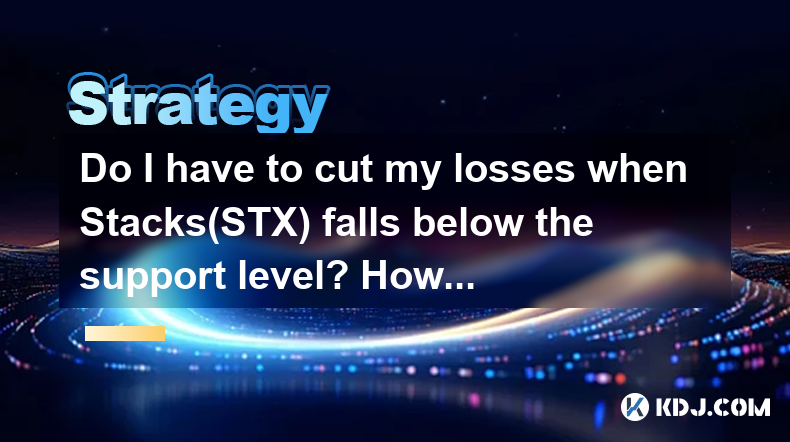-
 bitcoin
bitcoin $110047.851143 USD
-1.37% -
 ethereum
ethereum $3727.617466 USD
-1.30% -
 tether
tether $1.000961 USD
-0.05% -
 bnb
bnb $1114.045467 USD
1.72% -
 xrp
xrp $2.343280 USD
0.14% -
 solana
solana $174.674876 USD
-5.85% -
 usd-coin
usd-coin $0.999999 USD
0.02% -
 tron
tron $0.311757 USD
-2.44% -
 dogecoin
dogecoin $0.183678 USD
-3.76% -
 cardano
cardano $0.627109 USD
-2.07% -
 ethena-usde
ethena-usde $1.000300 USD
0.15% -
 hyperliquid
hyperliquid $36.865760 USD
-2.74% -
 chainlink
chainlink $16.968918 USD
-1.48% -
 stellar
stellar $0.318159 USD
0.47% -
 bitcoin-cash
bitcoin-cash $500.637224 USD
-1.56%
Do I have to cut my losses when Stacks(STX) falls below the support level? How to judge a false break?
When STX falls below support, assess market conditions and your strategy before cutting losses; use volume and technical indicators to identify potential false breaks.
May 03, 2025 at 07:42 am

When dealing with cryptocurrencies like Stacks (STX), understanding when to cut losses and how to identify a false break can be crucial for managing your investments effectively. The decision to cut losses when STX falls below a support level is not always straightforward and requires a nuanced approach. Similarly, identifying a false break involves analyzing market patterns and indicators. Let's delve into these topics to provide you with a comprehensive understanding.
Understanding Support Levels and Cutting Losses
Support levels are price points at which a cryptocurrency tends to find support as it falls. These levels are identified by looking at historical price data where the price has bounced back after reaching a certain level. When STX falls below a support level, it often signals a potential further decline in price, prompting investors to consider cutting their losses.
Cutting losses is a strategy to minimize financial damage by selling an asset at a loss to prevent further losses. However, whether you should cut your losses when STX falls below a support level depends on several factors:
- Your investment strategy: If you are a long-term investor, you might be willing to hold through short-term dips. If you are a short-term trader, you might be more inclined to cut losses quickly.
- Market conditions: Broader market trends and news can influence whether a drop below a support level is a temporary blip or a sign of a more sustained downturn.
- Risk tolerance: Your personal risk tolerance will dictate how much loss you are willing to absorb before selling.
To decide whether to cut losses, you need to assess these factors in the context of STX's performance and the overall market environment.
Identifying a False Break
A false break, also known as a fakeout, occurs when a price breaks through a support or resistance level but then quickly reverses direction. False breaks can be misleading and can lead to unnecessary selling or buying decisions. Here are some ways to judge a false break:
- Volume analysis: A false break often occurs with low trading volume. If the break below the support level is accompanied by low volume, it might be a false signal.
- Price action: Look for quick reversals back above the support level. If the price quickly rebounds after breaking the support, it could indicate a false break.
- Technical indicators: Use indicators like the Relative Strength Index (RSI) or Moving Average Convergence Divergence (MACD) to confirm the strength of the break. If these indicators do not confirm the break, it might be false.
Practical Steps to Analyze STX's Support Levels
To effectively analyze whether STX has fallen below a support level and whether it's a false break, follow these steps:
- Identify the support level: Use a charting tool to plot historical price data of STX. Look for levels where the price has consistently bounced back.
- Monitor the price movement: Keep an eye on STX's price as it approaches the identified support level. If it falls below, note the exact price and time.
- Check trading volume: Use the volume indicator on your charting tool to see if the break below the support level is accompanied by high or low volume.
- Analyze price action: Watch how the price behaves after breaking the support level. A quick reversal might indicate a false break.
- Use technical indicators: Apply RSI and MACD to your chart to see if they confirm the break or suggest a false break.
Deciding Whether to Cut Losses
Once you've identified that STX has fallen below a support level, consider the following to decide whether to cut your losses:
- Review your investment strategy: Are you in STX for the long haul, or are you looking for short-term gains? Your strategy will influence your decision.
- Assess the broader market: Is the entire crypto market experiencing a downturn, or is STX's drop isolated? This context can help you understand the significance of the support level break.
- Evaluate your risk tolerance: How much loss are you willing to accept? If the drop below the support level exceeds your comfort level, it might be time to cut losses.
Using Technical Indicators to Confirm False Breaks
Technical indicators can be invaluable in confirming whether a break below a support level is false. Here's how to use them effectively:
- Relative Strength Index (RSI): The RSI measures the speed and change of price movements. If the RSI does not show an oversold condition when STX breaks below a support level, it might indicate a false break.
- Moving Average Convergence Divergence (MACD): The MACD can help identify momentum shifts. If the MACD does not confirm the break below the support level, it could be a false signal.
Practical Example of Analyzing a False Break
Let's consider a hypothetical scenario where STX is trading at $1.50 and has a support level at $1.40. If STX briefly drops to $1.38 but then quickly rebounds to $1.45, this could be a false break. Here's how you would analyze it:
- Volume analysis: If the drop to $1.38 occurred with low volume, it might suggest a false break.
- Price action: The quick rebound to $1.45 indicates that the break below $1.40 was not sustained.
- Technical indicators: If the RSI did not show an oversold condition at $1.38 and the MACD did not confirm the break, these indicators would further support the notion of a false break.
By following these steps and using these indicators, you can make more informed decisions about whether to cut losses or hold onto your STX investment.
Frequently Asked Questions
Q1: How often should I check the support levels of STX?You should check the support levels of STX regularly, especially if you are actively trading or if the market is experiencing volatility. Daily checks can be beneficial for short-term traders, while weekly checks might suffice for long-term investors.
Q2: Can other cryptocurrencies influence the support levels of STX?Yes, other cryptocurrencies can influence the support levels of STX. If major cryptocurrencies like Bitcoin or Ethereum experience significant price movements, it can impact the broader market sentiment and, consequently, the support levels of STX.
Q3: Is it possible for a false break to turn into a real break?Yes, a false break can sometimes turn into a real break if the market conditions change. If the initial break below the support level is followed by sustained selling pressure and increased volume, what initially appeared to be a false break could become a real one.
Q4: How can I use stop-loss orders to manage my STX investments?You can use stop-loss orders to automatically sell your STX if it falls below a certain price, helping you manage your losses. Set the stop-loss order just below the identified support level to protect your investment from significant drops.
Disclaimer:info@kdj.com
The information provided is not trading advice. kdj.com does not assume any responsibility for any investments made based on the information provided in this article. Cryptocurrencies are highly volatile and it is highly recommended that you invest with caution after thorough research!
If you believe that the content used on this website infringes your copyright, please contact us immediately (info@kdj.com) and we will delete it promptly.
- XRP Price Prediction: Weekend Rollercoaster or Rally?
- 2025-10-12 08:45:16
- Bittensor (TAO): Super Bullish Signals Point to Potential 2x Rally
- 2025-10-11 10:25:12
- Silver Price Correction: Navigating the Dip & Identifying Key SEO Keywords
- 2025-10-11 10:25:12
- Decoding Crypto Trends: Bittensor's Bull Run, Cardano's Dip, and LivLive's Presale Buzz in 'Uptober 2025'
- 2025-10-12 08:45:16
- MoonBull: The Crypto Meme Coin Promising 1000x Gains?
- 2025-10-11 10:30:01
- Crypto Payroll Revolution: Stablecoins, Altcoins, and the Future of Salary Payments
- 2025-10-11 10:30:01
Related knowledge

Practical parameter settings for a Bitcoin multi-timeframe moving average system
Sep 18,2025 at 10:54pm
Optimizing Timeframe Combinations for Bitcoin Trading1. Selecting appropriate timeframes is crucial when building a multi-timeframe moving average sys...

How can I filter out false breakouts in Dogecoin high-frequency trading?
Sep 22,2025 at 01:00am
Understanding False Breakouts in Dogecoin Trading1. A false breakout occurs when Dogecoin's price appears to move beyond a defined support or resistan...

Techniques for identifying tops and bottoms in the Bitcoin on-chain NVT model
Sep 20,2025 at 07:54pm
Understanding the NVT Model in Bitcoin Analysis1. The Network Value to Transactions (NVT) ratio is often described as the 'P/E ratio' of the cryptocur...

What does the surge in open interest in Bitcoincoin futures mean?
Sep 20,2025 at 11:18pm
Understanding the Surge in Dogecoin Futures Open Interest1. A surge in open interest within Dogecoin futures indicates a growing number of active cont...

How can I use the Ethereum USDT premium to gauge market sentiment?
Sep 18,2025 at 11:55pm
Understanding the Ethereum USDT Premium1. The Ethereum USDT premium refers to the price difference between USDT (Tether) traded on Ethereum-based plat...

What should I do if Ethereum staking yields decline?
Sep 20,2025 at 06:18am
Understanding the Causes Behind Declining Ethereum Staking Yields1. The Ethereum network transitioned to a proof-of-stake consensus mechanism with the...

Practical parameter settings for a Bitcoin multi-timeframe moving average system
Sep 18,2025 at 10:54pm
Optimizing Timeframe Combinations for Bitcoin Trading1. Selecting appropriate timeframes is crucial when building a multi-timeframe moving average sys...

How can I filter out false breakouts in Dogecoin high-frequency trading?
Sep 22,2025 at 01:00am
Understanding False Breakouts in Dogecoin Trading1. A false breakout occurs when Dogecoin's price appears to move beyond a defined support or resistan...

Techniques for identifying tops and bottoms in the Bitcoin on-chain NVT model
Sep 20,2025 at 07:54pm
Understanding the NVT Model in Bitcoin Analysis1. The Network Value to Transactions (NVT) ratio is often described as the 'P/E ratio' of the cryptocur...

What does the surge in open interest in Bitcoincoin futures mean?
Sep 20,2025 at 11:18pm
Understanding the Surge in Dogecoin Futures Open Interest1. A surge in open interest within Dogecoin futures indicates a growing number of active cont...

How can I use the Ethereum USDT premium to gauge market sentiment?
Sep 18,2025 at 11:55pm
Understanding the Ethereum USDT Premium1. The Ethereum USDT premium refers to the price difference between USDT (Tether) traded on Ethereum-based plat...

What should I do if Ethereum staking yields decline?
Sep 20,2025 at 06:18am
Understanding the Causes Behind Declining Ethereum Staking Yields1. The Ethereum network transitioned to a proof-of-stake consensus mechanism with the...
See all articles










































































